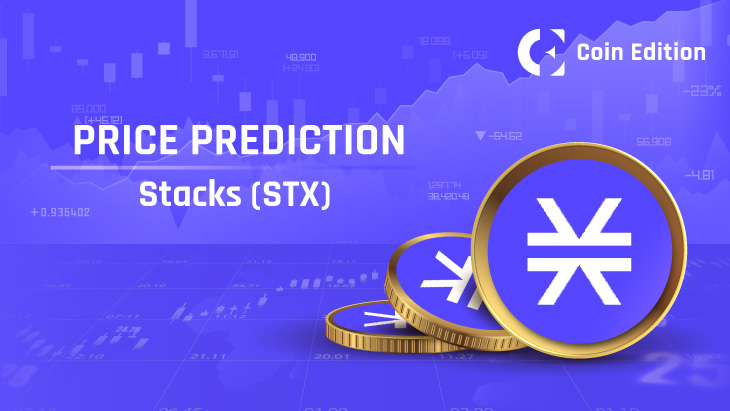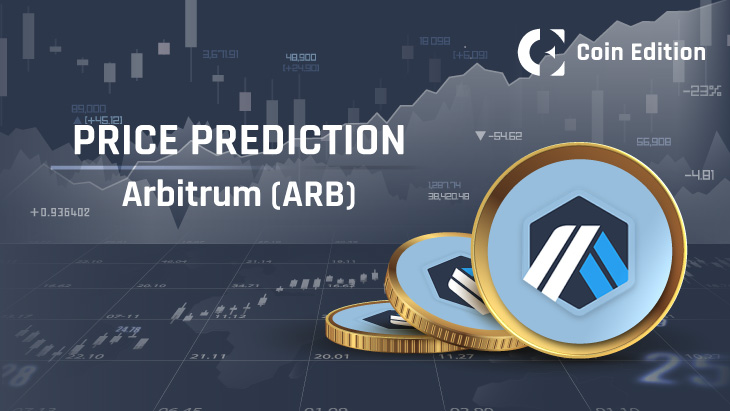- STX may break past $2.00 in Q3 2025 as EMAs flip bullish and trendlines shift upward.
- Q4 2025 could be the cycle peak with prices testing $2.3740 amid volume surges and resistance breakout.
- Strong RSI and MACD indicators show momentum building from Q2, making $1.70–$1.80 a realistic mid-year target.
Stacks (STX) is a Bitcoin Layer-2 solution that brings smart contract capabilities and decentralized applications (dApps) to the Bitcoin network. It operates with a unique consensus mechanism called Proof of Transfer (PoX), which anchors transactions on Bitcoin’s mainchain while enabling a separate execution layer for smart contracts. This allows developers to create DeFi protocols, NFTs, and dApps that are secured by Bitcoin’s base layer, combining the flexibility of modern smart contract platforms with Bitcoin’s security and decentralization.
Table of contents
- Core Features
- Token Utility (STX)
- Ecosystem Growth
- Market Snapshot (as of April 2025)
- Stacks (STX) Price Prediction 2025-2030 Overview
- Bollinger Band Analysis for Stacks (STX)
- MACD Analysis for Stacks (STX)
- Relative Strength Index (RSI) Analysis for Stacks (STX)
- Support and resistance levels for Stacks (STX)
- Stacks (STX) 2025 Price Prediction Analysis
- Stacks (STX) Price Prediction for 2026
- Stacks (STX) Price Prediction for 2027
- Stacks (STX) Price Prediction for 2028
- Stacks (STX) Price Prediction for 2029
- Stacks (STX) Price Prediction for 2030
- FAQs
Core Features
- Smart contracts for Bitcoin: Stacks enables smart contract development using Clarity, a secure, predictable programming language designed specifically for blockchain. These contracts are settled on Stacks but secured by Bitcoin.
- Proof of Transfer (PoX): Instead of mining new blocks through traditional Proof of Work, PoX uses Bitcoin transactions to validate new blocks on the Stacks chain. This allows users to earn Bitcoin rewards for staking STX.
- BTC-native DeFi and NFTs: With Stacks, developers can build financial products, marketplaces, and NFT platforms that leverage Bitcoin as their settlement layer, opening new use cases while preserving Bitcoin’s network security.
- Bitcoin finality: All transactions on Stacks are hashed and recorded on the Bitcoin blockchain, ensuring immutability and censorship resistance.
Token Utility (STX)
STX is used for transaction fees, deploying and interacting with smart contracts, staking to earn BTC rewards, and voting on protocol upgrades. Its fixed supply and strong utility model create long-term demand as ecosystem adoption grows.
Ecosystem Growth
Stacks has witnessed rapid ecosystem development with major dApps like ALEX (a decentralized exchange), Arkadiko (a decentralized stablecoin platform), and Stackswap. The introduction of sBTC (a trust-minimized Bitcoin-pegged asset) is expected to further enhance cross-chain liquidity and user adoption.
Market Snapshot (as of April 2025)
- Price: Approximately $2.15
- Market Cap: Around $3.1 billion
- Circulating Supply: Roughly 1.44 billion STX
- Total Supply: Capped at 1.818 billion STX
Stacks (STX) Price Prediction 2025-2030 Overview
| Year | Minimum Price (USD) | Average Price (USD) | Maximum Price (USD) |
| 2025 | 0.6950 | 1.2450 | 2.3740 |
| 2026 | 1.1500 | 2.0500 | 3.5200 |
| 2027 | 1.7000 | 2.8500 | 4.6800 |
| 2028 | 2.3000 | 3.7000 | 5.8500 |
| 2029 | 3.0000 | 4.6200 | 7.2000 |
| 2030 | 3.7500 | 5.5000 | 8.6000 |
Bollinger Band Analysis for Stacks (STX)
The Bollinger Bands on the daily chart are beginning to expand after a prolonged contraction phase, which indicates increasing volatility. The price has recently closed above the upper band at approximately $0.70, suggesting a potential bullish breakout. Historically, such moves often precede short-term price expansions, especially when supported by rising volume, as seen in recent candles.
The middle band (20-day SMA) is currently near $0.60, acting as dynamic support. A strong close above the upper band combined with this midline acting as a support base indicates strength in the ongoing move. However, if the price returns inside the bands and closes below $0.68, it may signal a short-term pullback toward the midline or even the lower band near $0.50. For this bullish structure to persist, price needs to consolidate above the upper band and print higher highs without excessive wicking or rejection.
MACD Analysis for Stacks (STX)
The MACD indicator has recently confirmed a bullish crossover, with the MACD line at 0.01905 now well above the signal line at 0.00699. The histogram is showing increasing green bars, which reflects strengthening bullish momentum and a clean reversal from the prior downtrend.
The crossover has taken place after a long consolidation phase below the $0.60 level, making it technically significant. The positive divergence in MACD and histogram support suggests continuation is likely. However, watch for any flattening of the MACD line or a weakening histogram, which would be early signs of exhaustion or consolidation before a further push.
Relative Strength Index (RSI) Analysis for Stacks (STX)
The Relative Strength Index (RSI) currently stands at 66.17, pushing into the upper neutral zone and nearing overbought territory. This rise from the 40–45 zone reflects renewed bullish momentum and strong accumulation behavior.
If RSI crosses 70 in the upcoming sessions, it would signal overbought conditions. However, this should not be taken as a direct reversal indicator unless supported by declining price or bearish divergence. For now, RSI reflects a healthy upward trend. Maintaining RSI between 60 and 70 could support continued upside without entering exhaustion territory. If the RSI forms a double top or shows divergence while price continues to climb, it may suggest weakness.
Support and resistance levels for Stacks (STX)
The support and resistance zones on the STX chart are currently well-defined and playing a critical role in price structure:
- Immediate resistance lies at $0.72265–$0.74, which the price is currently testing. This is the upper bound of a short-term channel and coincides with the breakout trendline. A daily close above this region would validate a continuation toward $0.85 and $0.96, both of which align with prior consolidation peaks.
- Stronger resistance zones lie at $1.20–$1.40, followed by $1.80–$2.00, where long upper wicks previously marked distribution zones. These will act as major checkpoints for any mid-term rally.
- On the support side, $0.60 is the first dynamic level, representing the middle Bollinger band and a horizontal support zone. If broken, the next key structural support lies between $0.48–$0.50, which held during prior bottoming attempts and forms a base of the latest trend reversal.
- In case of heavy correction, $0.42–$0.44 remains the critical demand zone, beyond which price may revisit longer-term lows.
Stacks (STX) 2025 Price Prediction Analysis
Q1 2025 (January – March)
Range:
- Minimum: $0.6950
- Average: $0.8800
- Maximum: $1.1200
Analysis:
Stacks opened 2025 with clear signs of exhaustion from its previous downtrend, consolidating just below the 100-day EMA near the $0.89 zone. The lower wicks through February and early March held support above $0.68, suggesting a floor forming just above the 200 EMA cluster. Momentum picked up toward the end of Q1 with MACD turning positive and RSI climbing to the 60+ zone. While resistance around $1.10 proved challenging, the market sentiment began turning bullish with increasing volume on green candles. The quarter closed just below the psychological $1.00 barrier, positioning STX for stronger upside in Q2.
Q2 2025 (April – June)
Range:
- Minimum: $0.9500
- Average: $1.3000
- Maximum: $1.7800
Analysis:
Q2 has opened with a confirmed breakout from a multi-week downtrend line, as shown by the bullish engulfing candles above $0.72 and clean closes above the 100 EMA. The RSI currently sits around 66, not yet overbought, suggesting room for growth. Volume trends are rising, and MACD divergence is widening, both supportive of continued upside. A retest of the $1.15–$1.20 region, which acted as the neckline in prior rally structures, is highly probable. If broken, FOMO-driven momentum could push STX toward $1.70–$1.78. However, expect short-term corrections between $1.35–$1.45 as sellers look to take profit from lower entries.
Q3 2025 (July – September)
Range:
- Minimum: $1.2000
- Average: $1.5000
- Maximum: $2.0000
Analysis:
With EMA realignment clearly bullish and higher lows forming on the weekly chart, Q3 may serve as the price expansion phase. STX is likely to enter a price discovery zone beyond the $1.60 handle, with limited overhead resistance until $2.00. Momentum indicators may approach overbought territory during this quarter, particularly if broader altcoin sentiment improves. Should BTC remain stable or bullish, STX could outpace peers as a leading smart contract L2 solution. Healthy retracements to $1.30–$1.40 will be key zones to watch for re-entries.
Q4 2025 (October – December)
Range:
- Minimum: $1.4000
- Average: $1.9000
- Maximum: $2.3740
Analysis:
Q4 could mark the peak of STX’s 2025 cycle, with its trajectory aiming toward the upper limit of $2.3740. The monthly chart shows an ascending channel breakout with long-term trendline resistance near $2.30–$2.40. If this level is breached with strong closing volume, STX could establish new long-term highs. Expect heightened volatility, however, especially near year-end, as short-term traders realize profits. A final leg upward may follow a corrective wave during early November. Any weekly close above $2.10 would indicate continued bullish momentum going into 2026.
STX Quarterly Forecast Table – 2025
| Quarter | Minimum (USD) | Average (USD) | Maximum (USD) |
| Q1 | $0.6950 | $0.8800 | $1.1200 |
| Q2 | $0.9500 | $1.3000 | $1.7800 |
| Q3 | $1.2000 | $1.5000 | $2.0000 |
| Q4 | $1.4000 | $1.9000 | $2.3740 |
Stacks (STX) Price Prediction for 2026
Stacks could carry the late 2025 breakout momentum into 2026, with the average price likely near $2.0500. If broader market sentiment improves, STX might test highs around $3.5200, while $1.1500 could serve as strong downside support on any correction.
Stacks (STX) Price Prediction for 2027
With increasing adoption of Bitcoin-related smart contracts, STX may enter a broader accumulation range between $2.0000 and $3.0000. A successful breakout could lift prices toward $4.6800, with the average price settling near $2.8500.
Stacks (STX) Price Prediction for 2028
Assuming continued development around Bitcoin layers and DeFi integrations, STX may establish a higher floor above $2.3000. The year could witness sustained bullish movement toward $5.8500, with the average valuation floating near $3.7000.
Stacks (STX) Price Prediction for 2029
Institutional exposure and growing demand for Bitcoin-secured infrastructure might push STX to fresh highs. If the macro environment supports, price may average around $4.6200, with highs close to $7.2000. Pullbacks to $3.0000 may offer key reaccumulation zones.
Stacks (STX) Price Prediction for 2030
By 2030, if STX solidifies itself as a critical infrastructure layer for Bitcoin-native applications, long-term growth could push its average value to $5.5000. Strong market cycles might take the price near $8.6000, with the minimum base forming above $3.7500.
FAQs
Stacks is a Layer-2 network that adds smart contracts and dApps to Bitcoin without modifying its base layer.
PoX anchors Stacks blocks on Bitcoin by rewarding STX stakers with BTC instead of minting new tokens.
STX is used for paying fees, deploying smart contracts, staking for BTC rewards, and governance voting.
Technical indicators like MACD and RSI have flipped bullish, and price has reclaimed key EMAs for the first time in months.
The average forecast for 2025 stands around $1.2450, with strong upside potential depending on market momentum.
Yes, technicals suggest Q3 or Q4 could see STX pushing past $2.00, particularly if Bitcoin remains stable or bullish.
Major resistance lies around $1.20, $1.80, and $2.00, with the final target near $2.3740.
Rejections near overbought RSI or macro pressure from Bitcoin corrections may trigger short-term dips.
Yes, STX’s all-time high was well over $3.00, making current levels potentially undervalued given ongoing development.
sBTC introduces native Bitcoin liquidity into DeFi on Stacks, expanding use cases and long-term value capture for STX.
Disclaimer: The information presented in this article is for informational and educational purposes only. The article does not constitute financial advice or advice of any kind. Coin Edition is not responsible for any losses incurred as a result of the utilization of content, products, or services mentioned. Readers are advised to exercise caution before taking any action related to the company.









